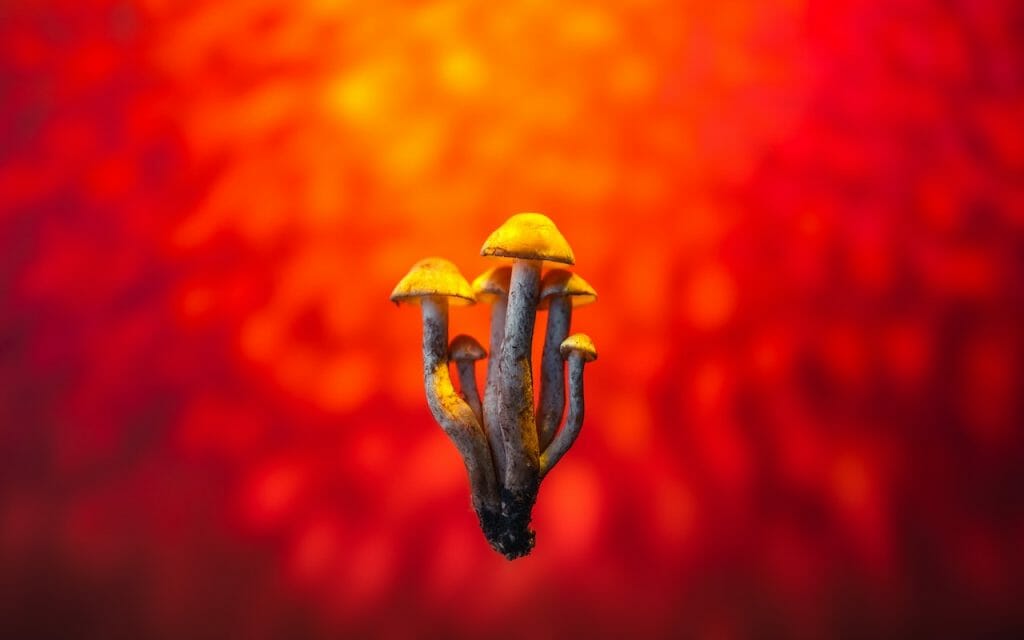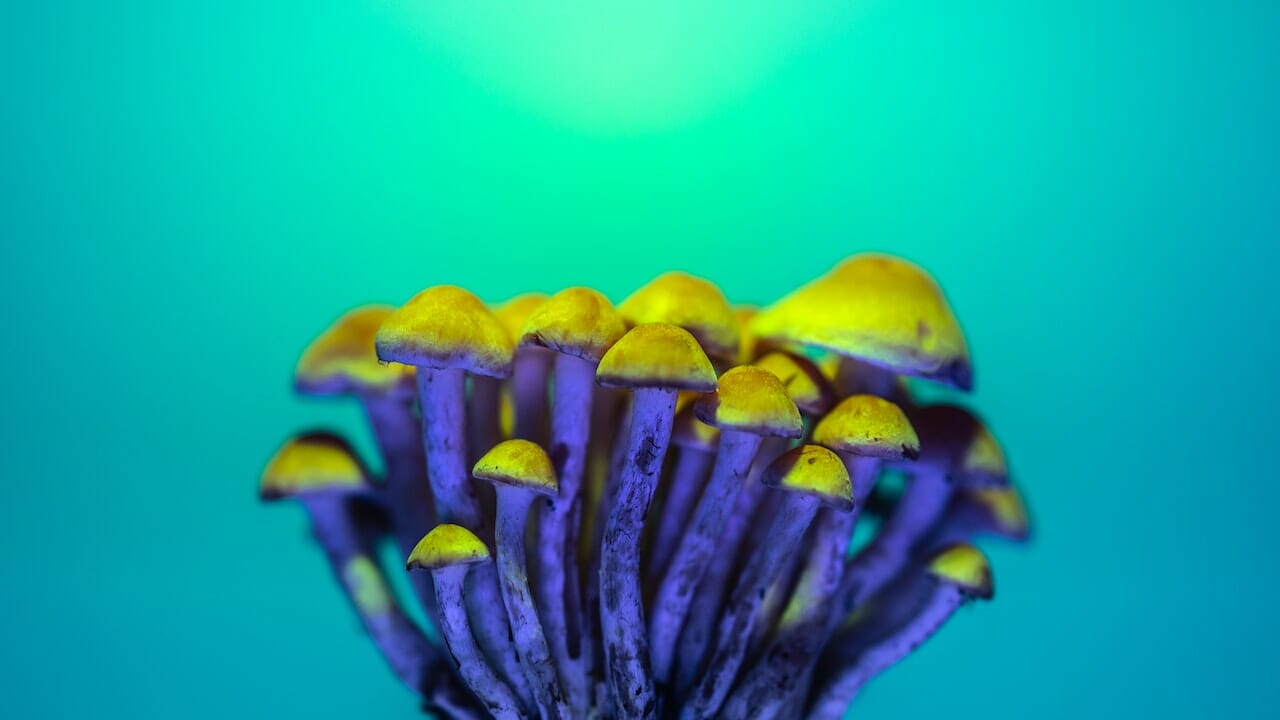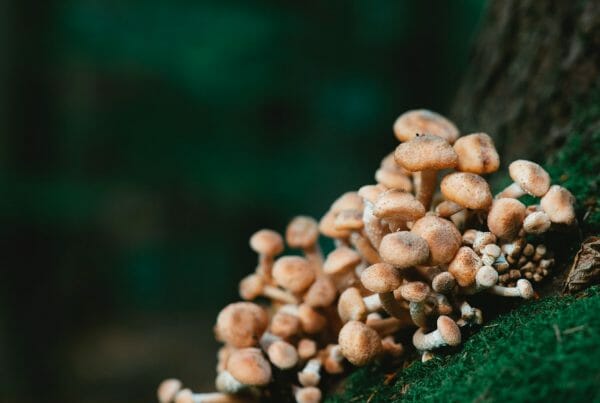LSD (lysergic acid diethylamide) is an incredibly powerful hallucinogen that has been extensively studied in the field of psychedelics. While it was predominantly used for recreational purposes in its early days, LSD has evolved into a psychoactive substance that may have potential mental health benefits. This change in perception has sparked new research into more consumable forms of LSD, such as LSD edibles.
Key Takeaways:
- LSD is a powerful hallucinogen derived from the ergot fungus.
- LSD shares similarities with psilocybin and interacts with 5-HT2A receptors.
- LSD can cause shifts in visual perception, mood changes, ego dissolution, and pseudo-hallucinations.

Demystifying LSD
LSD is a remarkably potent hallucinogen that can significantly alter a person’s sense of reality and profoundly distort sensory perceptions. LSD is derived from “ergot,” a fungus that grows on rye and other grains.
At the molecular level, LSD is a complex chemical belonging to the ergoline family. It comprises a hexahydroindole group and a bicyclic quinoline group (lysergic acid), both of which are bicyclic. The term ‘Lysergic Acid Diethylamide’ originates from the functional group attached to its core. The structure of LSD resembles other ergoline alkaloids, such as ergotamine, found in the ergot fungus Claviceps purpurea, and the neurotransmitter serotonin.
The Effects of LSD
Upon consumption, LSD reaches the brain and sets off a series of chemical reactions that can persist for several hours. LSD can induce the following short-term effects:
- Unpredictable mood fluctuations
- Distortion of perception
- Dizziness
- Decreased appetite
- Impaired motor control
The Advantages What are the Benefits of LSD Consumption?
The benefits of LSD are diverse and largely depend on the dosage consumed. Much of the existing research concentrates on the positive effects derived from the intake of moderate amounts of this psychedelic compound. Herein, we discuss the potential benefits associated with LSD use.
Pain Relief and Neuronal Development
Researchers at Maastricht University discovered that a single microdose of LSD can induce analgesic effects that persist for a minimum of five hours.
In the Cold Pressor Test, where participants immerse their hands in 3°C (37.4°F) water for as long as possible, those who consumed 20 mg of LSD managed to keep their hands submerged 20% longer than the non-users. They also reported less pain and discomfort.
In addition, LSD can aid in the development and growth of the 86 billion neurons present in our brain. Moderate LSD doses, ranging from 5 to 20 ug, increase the BDNF levels in blood plasma. This is noteworthy because mood disorders like depression, often associated with neuroplasticity issues, can potentially be mitigated through LSD’s beneficial impact on neuronal health.
Mental Health Enhancement
Dr. Robin Carhart-Harris from Imperial College London proposed the entropic brain hypothesis. This concept posits that mental health disorders result from rigid thought patterns, perpetuated by an excessively active default mode network (DMN). Psychedelic substances like LSD can disrupt the DMN, increase brain entropy, and help dissolve harmful neural pathways while promoting the creation of beneficial ones.
A study involving over 1,000 microdosers recorded a decrease in depression symptoms. Another large-scale study demonstrated a decline in negative moods and harmful attitudes, along with an increase in open-mindedness and cognitive function.
Addiction Treatment
A comprehensive analysis of randomized-controlled clinical trials using LSD in psychiatry determined that it is most effective in treating alcohol dependency. This conclusion is further reinforced by the successful results achieved by numerous patients treated for alcoholism by Humphrey Osmond and at the Spring Grove Hospital Centre during the 1950s and 1960s.
Easing Anxiety and Depression in End-of-Life Situations
Dr. Peter Gasser’s research has shown that LSD-assisted psychotherapy can significantly reduce anxiety related to end-of-life in terminally ill cancer patients, and enhance their perceived quality of life. Currently, a Phase 2 trial is underway to further explore the potential benefits of LSD therapy for depression.
Deciphering LSD Edibles: Their Composition and Manufacturing Process
LSD edibles refer to food and beverage items infused with the hallucinogenic compound, LSD. The forms they can take are diverse, including chocolates, candies, baked treats, and even unconventional items such as LSD mints.
What They Contain
- LSD: This is the active ingredient that triggers hallucinogenic effects. Its dosage is carefully measured and incorporated into the edible.
- Edible Base: The LSD is usually dissolved or mixed into a consumable base such as a gummy, candy, sugar cube, or other edible substances. These bases act as carriers for the hallucinogenic compound.
- Flavouring and Ingredients: The specific edible may also include flavourings, sweeteners, and other ingredients to enhance taste and texture. These may be natural or synthetic flavourings, colours, and sugars, and can vary greatly.
The Making Process:
- LSD Synthesis: The first step is the chemical production of LSD. It requires extensive knowledge in organic chemistry and access to the necessary chemicals, equipment, and a laboratory.
- Liquid Formulation: After the LSD is produced, it is typically transformed into a liquid form by dissolving it in a solvent. This liquid acts as a concentrated LSD solution.
- Infusion: The liquid LSD is then integrated into an edible medium such as gummy candies, sugar cubes, or blotter paper. The medium absorbs the liquid, thus, making the LSD consumable orally.
Exploring the Psychedelic Effects of Psychoactive Substances in LSD Edibles
LSD triggers intense visual effects. Colours seem more vivid, objects might seem to be encircled by halos or rainbows, and shapes can appear to transform. Regardless of whether the eyes are opened or closed, users may see
LSD generates vibrant and rapidly changing geometric patterns among other visual distortions. These effects are known as “pseudo-hallucinations” given that users are aware that they are not real but are induced by the drug.
LSD serves as a tool to modify one’s self-perception and interpretation of the environment. The substance can trigger a variety of mental states. Thoughts can appear clear and meaningful, or they might be devoid of logical connections. Other effects may include altered perceptions of time, space, and body image. The boundary between the self and the external world may seem blurred. Some users report experiencing sensory crossover, such as seeing music or hearing colours.
Suggested LSD Products
Various LSD edibles are available in the market, but it’s essential to buy from a trusted dispensary. Ensure that the edibles contain LSD and not other substances like PCP (embalming fluid), ecstasy, or ketamine.
Deadhead Chemist – LSD Infused Gummies
Deadhead Chemist offers LSD-infused edibles, each with 100 micrograms (ug) of LSD, in a range of flavours. Each package contains a single gummy, which has shown promise in aiding individuals with conditions such as obsessive-compulsive disorder (OCD), post-traumatic stress disorder (PTSD), alcoholism, depression, and cluster headaches.
Deadhead Chemist – Mint Tea
Deadhead Chemist’s raspberry mint tea provides a more pleasurable and tasty way to experience LSD’s effects. LSD and other psychedelics mimic the serotonin neurotransmitter and enhance the brain’s flow state.
Earthly Delights – Candy Flips
Candy flipping emerged during the late 1980s rave scene. Today, thrill-seekers and party enthusiasts continue to enjoy the powerful combination of these two substances. Users often report intense feelings of love and interconnectedness, paired with captivating visual effects such as colour enhancement, object metamorphosis, and intricate geometric patterns.
Concluding Remarks
LSD has historically played a role in transformative experiences. The scientific comprehension of this substance is increasingly sophisticated, leading to a popularity boom. The advent of LSD edibles provides a fresh way for individuals to partake. These flavorful delights have become
Engage in a safe and enjoyable LSD experience with carefully measured doses.
As Canada’s leading supplier of first-rate online shrooms, Psychedelic Canada provides an extensive array of LSD-enhanced edibles and cannabis goods. Peruse our selection at your pace, put your chosen products in your cart, and unwind at home while we handle the delivery. Our diverse range also includes psilocybin shrooms, edibles, drinks, and capsules for your convenience. Make sure to check out our LSD delivery page for additional details!
Frequently Asked Questions
How does LSD differ from psilocybin?
CHARACTERISTICS LSD PSILOCYBIN Origin Partially synthetic chemical compound Occurs naturally in fungi Possible Forms Tabs, microdots, liquid, gummies, blotter paper Dried mushrooms, capsules, teas, chocolates Potency Highly potent, microgram quantities (ug) Varies based on mushroom species and preparation Onset and Duration Quick onset (15-60 minutes), brief duration (3-5 hours) Gradual onset (30-60 minutes), medium duration (4-6 hours)
How can one avoid negative LSD experiences?
- Choose Your Setting Wisely
- Prime Your Mindset
- Start with a Small Dose
- Arrange for a Trip Supervisor
- Create a Soothing Environment
- Utilize Deep Breathing and Grounding Methods
- Accept and Release
What is the timescale for the effects?
The impact of the acid will start to show between 30-60 minutes post-consumption. Those with a greater sensitivity to psychedelics may begin to feel the effects Within a quarter of an hour, you will start to notice whether you’ve consumed acid. The peak of your trip will occur about three hours into your experience. During this time, it might feel as if time is slowing down and hallucinations may occur.
Hold on, it’s quite normal to feel a disconnection from reality during this phase. The peak phase can last between 3 and 5 hours, after which the offset phase lasts for an additional 3 to 5 hours.
How does LSD interact with the human body?
LSD mainly connects with the serotonin system in the brain by stimulating the 5-HT2A receptor to which it binds. This connection initiates a chain of neurochemical and physiological responses. The effects of LSD, which can greatly vary, can be influenced by specific factors.
Are there different forms of LSD apart from edibles?
Yes, LSD is available in various forms. The four primary forms of LSD products are blotter paper, liquid solutions, tablets/microdots, and gelatin sheets.
Further Reading:
| CHARACTERISTICS | LSD | PSILOCYBIN |
| Origin | Partially synthetic chemical compound | Occurs naturally in fungi |
| Possible Forms | Tabs, microdots, liquid, gummies, blotter paper | Dried mushrooms, capsules, teas, chocolates |
| Potency | Highly potent, microgram quantities (ug) | Varies based on mushroom species and preparation |
| Onset and Duration | Quick onset (15-60 minutes), brief duration (3-5 hours) | Gradual onset (30-60 minutes), medium duration (4-6 hours) |





